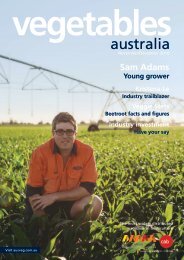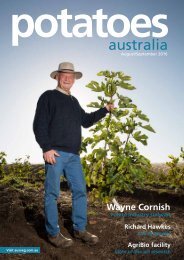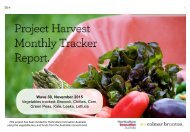vegetables
VA-MayJun2016
VA-MayJun2016
You also want an ePaper? Increase the reach of your titles
YUMPU automatically turns print PDFs into web optimized ePapers that Google loves.
27<br />
practices, such as planting<br />
cover crops, which can help<br />
them reap the rewards of<br />
increased soil health.<br />
“The use of cover crops has<br />
been really good at, in a very<br />
short time, seeing significant<br />
improvement in soil condition<br />
– that is, improved aggregate<br />
stability, better water penetration<br />
and even less soil-borne<br />
disease,” Dr Rogers explained.<br />
The project is also focusing<br />
on reducing tillage through<br />
methods that include controlled<br />
traffic farming (CTF), which<br />
introduces ‘traffic zones’ and<br />
‘growing zones’ to avoid farm<br />
machinery causing ongoing<br />
damage to soil that would later<br />
be used for crops.<br />
Controlled traffic farming<br />
Kalfresh Farms Director<br />
Rob Hinrichsen, based in<br />
Queensland, is an early adopter<br />
of CTF. He says that their<br />
growing operation has seen<br />
tangible benefits since they<br />
introduced the new system.<br />
“We’re seeing a lot more<br />
resilient crops – crops that are<br />
a lot more able to handle wet<br />
stress, even dry stress and heat<br />
stress,” Mr Hinrichsen said.<br />
“We don’t always see an<br />
increase in yield … but overall<br />
we’re seeing a much more<br />
resilient cropping system, and<br />
one that is a lot cheaper to run.<br />
“In the past, we were looking<br />
at between eight to 11 passes<br />
with machinery and tillage<br />
equipment to go from one crop<br />
to the next. Now we’ve got it<br />
down to three at a maximum –<br />
sometimes it’s none, sometimes<br />
it’s once.”<br />
Mr Hinrichsen says that<br />
growers who are considering<br />
their own practice changes<br />
should dive in and learn on the<br />
job.<br />
“We’ve had to come up<br />
with a system that works on<br />
our place – it may not work<br />
everywhere, but just through<br />
learning over time we’ve made<br />
improvements,” Mr Hinrichsen<br />
explained.<br />
“I think that for other growers<br />
who are looking on from the<br />
side, just try a bit and learn as<br />
you go – that’s the best way to<br />
do it.”<br />
The full interviews with<br />
researcher Dr Gordon<br />
Rogers, Queensland<br />
grower Rob Hinrichsen<br />
and AUSVEG Environment<br />
Coordinator Andrew Shaw,<br />
will be made available on<br />
InfoVeg Radio at ausveg.<br />
com.au/infovegradio.<br />
This communication was<br />
funded by Horticulture<br />
Innovation Australia using<br />
the National Vegetable<br />
Levy and funds from the<br />
Australian Government.<br />
Project Number: VG15027








